Financial Accounting Process - Case Study Analysis
VerifiedAdded on 2023/06/09
|14
|1648
|386
AI Summary
This case study analysis focuses on the financial accounting process of ChiHerbal Ltd. It covers scenarios related to balance sheet, lease treatment, and intangible assets. The analysis is based on the provisions of AASB 138 and IFRS.
Contribute Materials
Your contribution can guide someone’s learning journey. Share your
documents today.
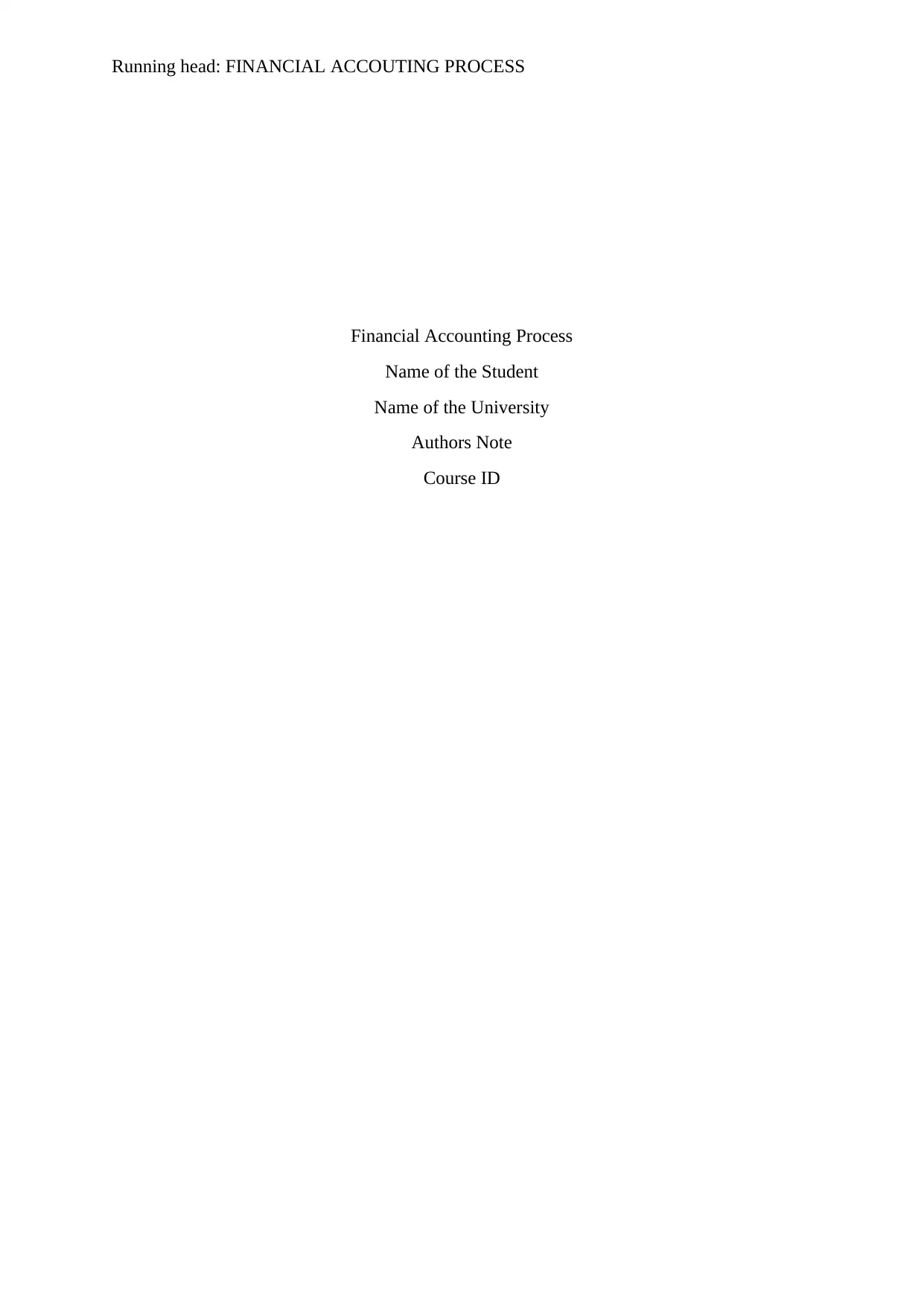
Running head: FINANCIAL ACCOUTING PROCESS
Financial Accounting Process
Name of the Student
Name of the University
Authors Note
Course ID
Financial Accounting Process
Name of the Student
Name of the University
Authors Note
Course ID
Secure Best Marks with AI Grader
Need help grading? Try our AI Grader for instant feedback on your assignments.
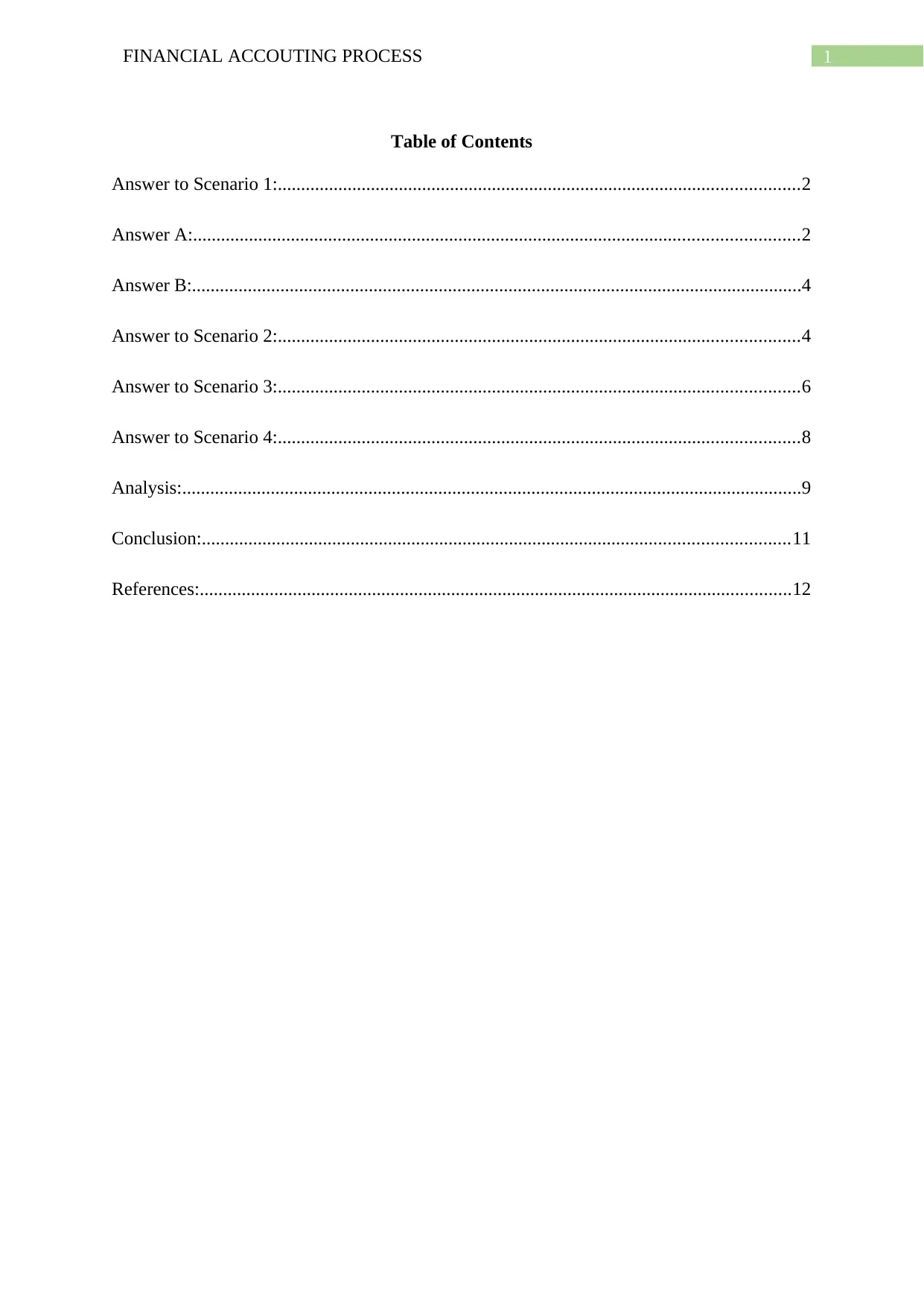
1FINANCIAL ACCOUTING PROCESS
Table of Contents
Answer to Scenario 1:................................................................................................................2
Answer A:..................................................................................................................................2
Answer B:...................................................................................................................................4
Answer to Scenario 2:................................................................................................................4
Answer to Scenario 3:................................................................................................................6
Answer to Scenario 4:................................................................................................................8
Analysis:.....................................................................................................................................9
Conclusion:..............................................................................................................................11
References:...............................................................................................................................12
Table of Contents
Answer to Scenario 1:................................................................................................................2
Answer A:..................................................................................................................................2
Answer B:...................................................................................................................................4
Answer to Scenario 2:................................................................................................................4
Answer to Scenario 3:................................................................................................................6
Answer to Scenario 4:................................................................................................................8
Analysis:.....................................................................................................................................9
Conclusion:..............................................................................................................................11
References:...............................................................................................................................12
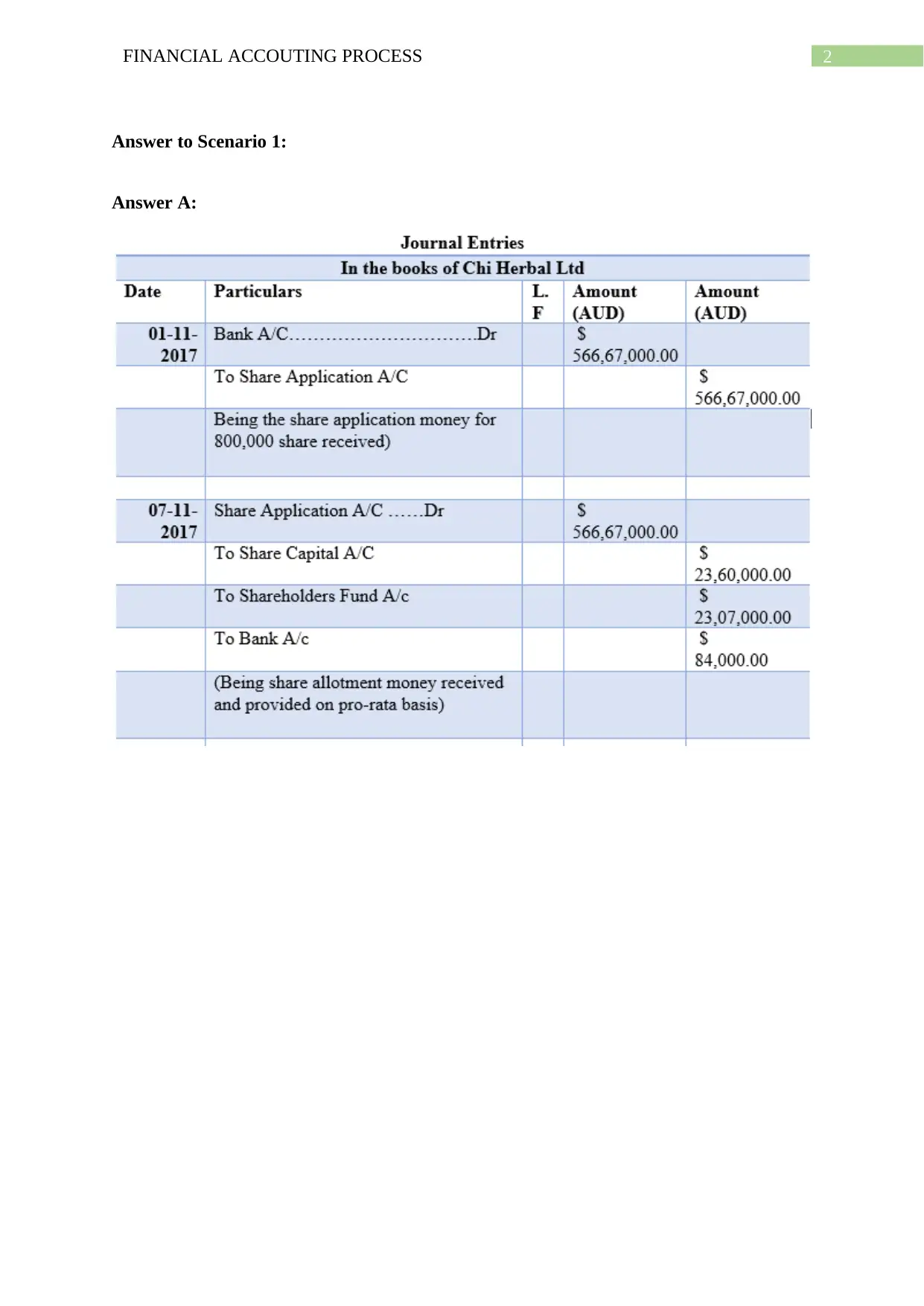
2FINANCIAL ACCOUTING PROCESS
Answer to Scenario 1:
Answer A:
Answer to Scenario 1:
Answer A:
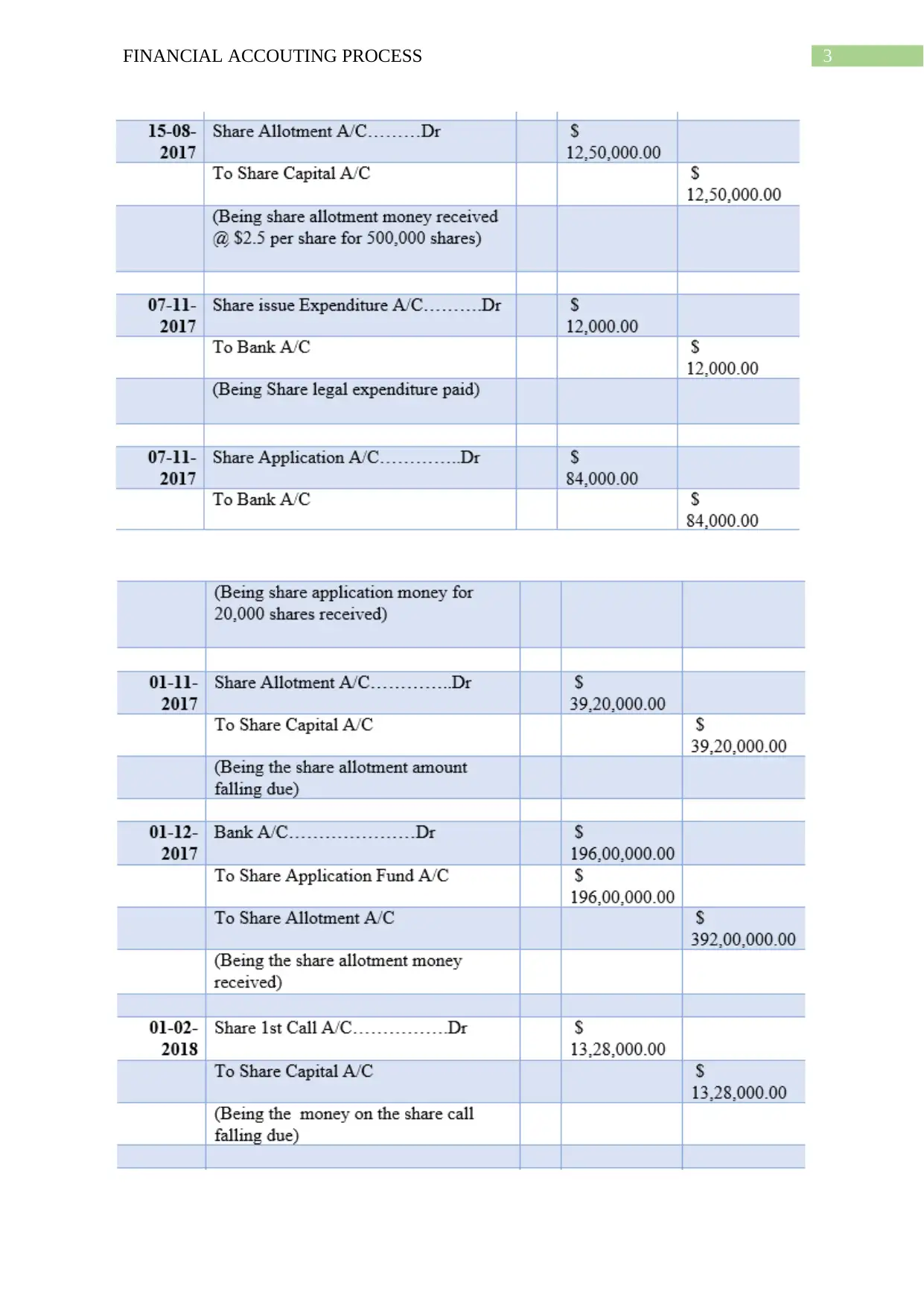
3FINANCIAL ACCOUTING PROCESS
Secure Best Marks with AI Grader
Need help grading? Try our AI Grader for instant feedback on your assignments.
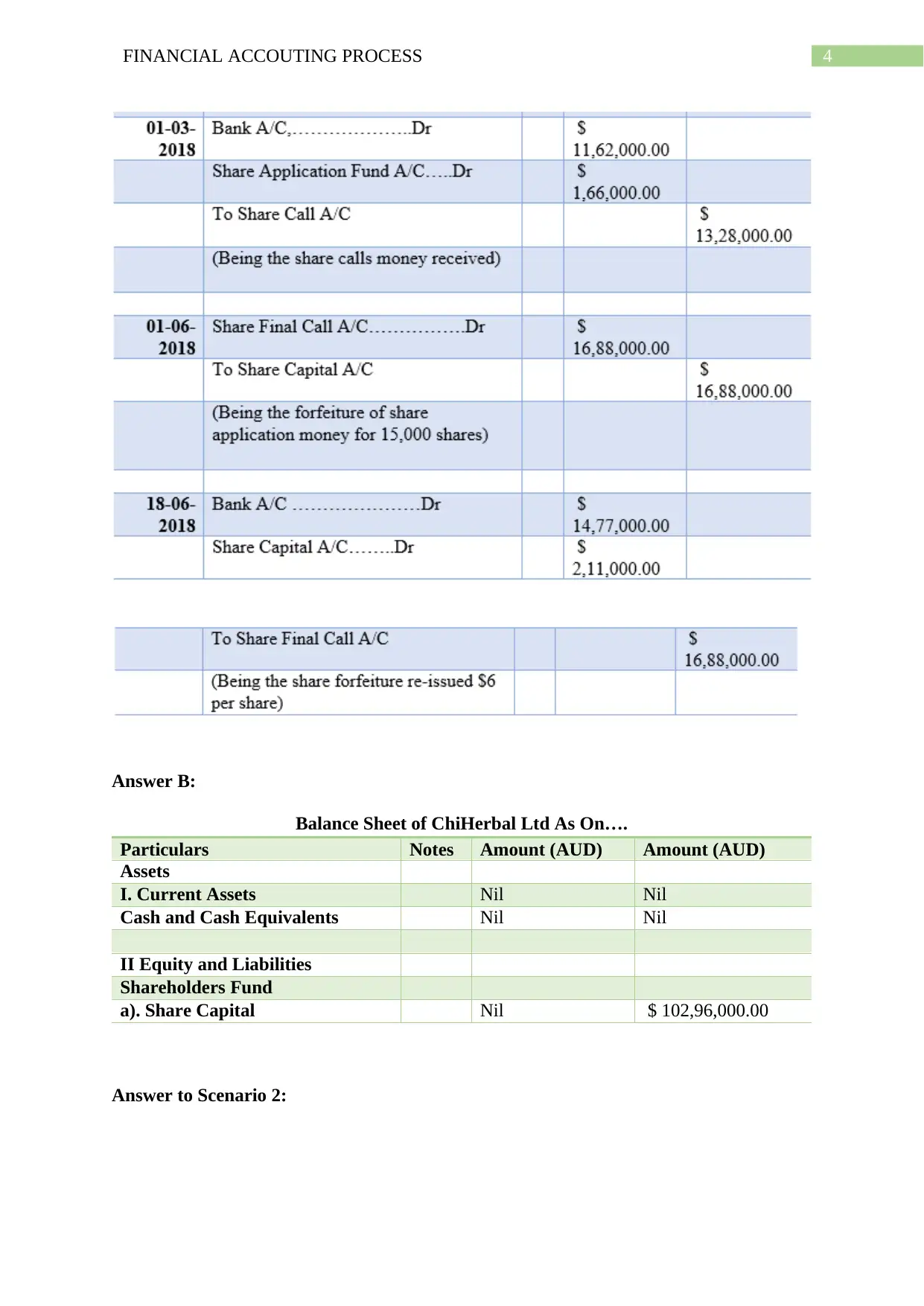
4FINANCIAL ACCOUTING PROCESS
Answer B:
Balance Sheet of ChiHerbal Ltd As On….
Particulars Notes Amount (AUD) Amount (AUD)
Assets
I. Current Assets Nil Nil
Cash and Cash Equivalents Nil Nil
II Equity and Liabilities
Shareholders Fund
a). Share Capital Nil $ 102,96,000.00
Answer to Scenario 2:
Answer B:
Balance Sheet of ChiHerbal Ltd As On….
Particulars Notes Amount (AUD) Amount (AUD)
Assets
I. Current Assets Nil Nil
Cash and Cash Equivalents Nil Nil
II Equity and Liabilities
Shareholders Fund
a). Share Capital Nil $ 102,96,000.00
Answer to Scenario 2:
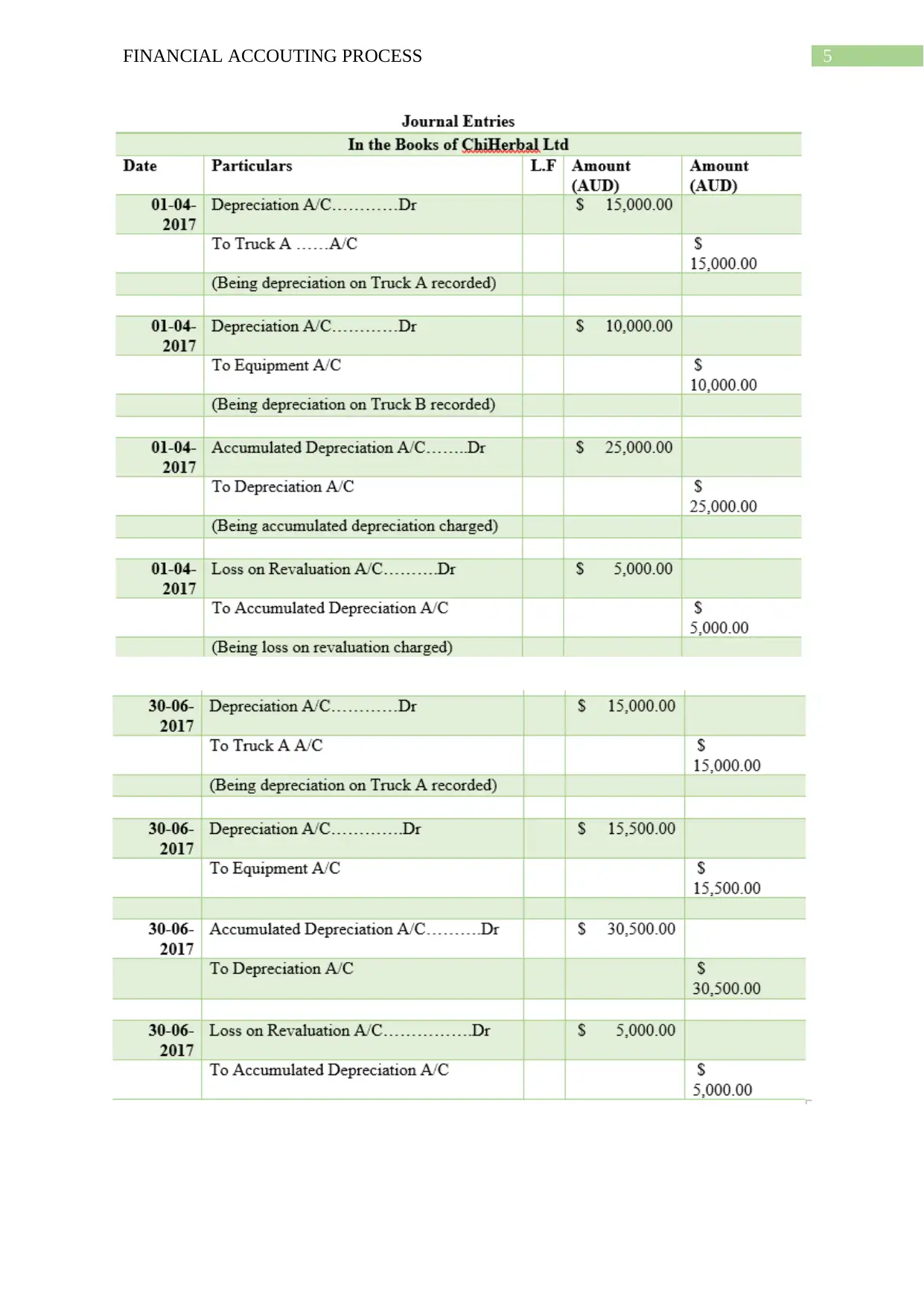
5FINANCIAL ACCOUTING PROCESS
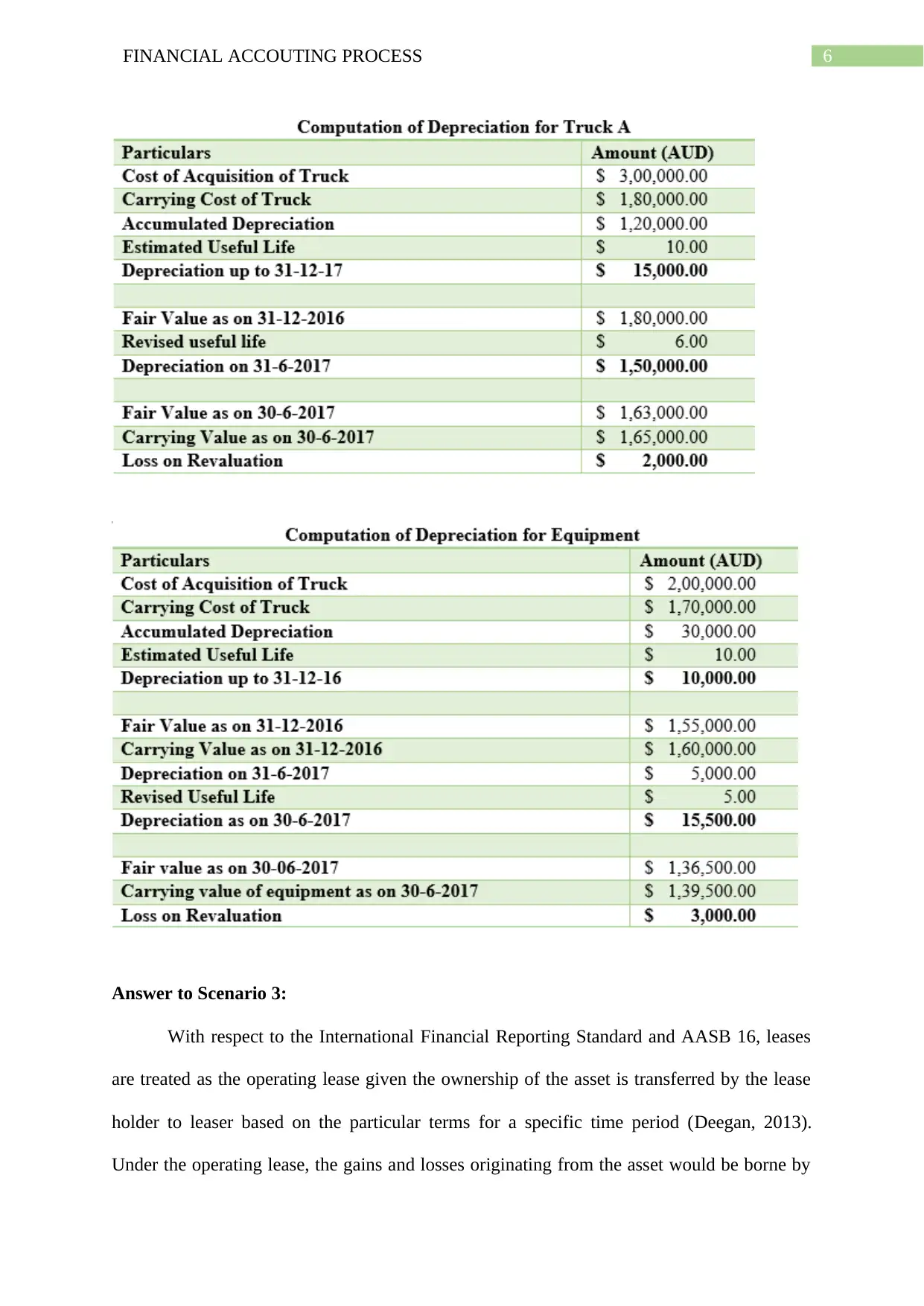
6FINANCIAL ACCOUTING PROCESS
Answer to Scenario 3:
With respect to the International Financial Reporting Standard and AASB 16, leases
are treated as the operating lease given the ownership of the asset is transferred by the lease
holder to leaser based on the particular terms for a specific time period (Deegan, 2013).
Under the operating lease, the gains and losses originating from the asset would be borne by
Answer to Scenario 3:
With respect to the International Financial Reporting Standard and AASB 16, leases
are treated as the operating lease given the ownership of the asset is transferred by the lease
holder to leaser based on the particular terms for a specific time period (Deegan, 2013).
Under the operating lease, the gains and losses originating from the asset would be borne by
Paraphrase This Document
Need a fresh take? Get an instant paraphrase of this document with our AI Paraphraser
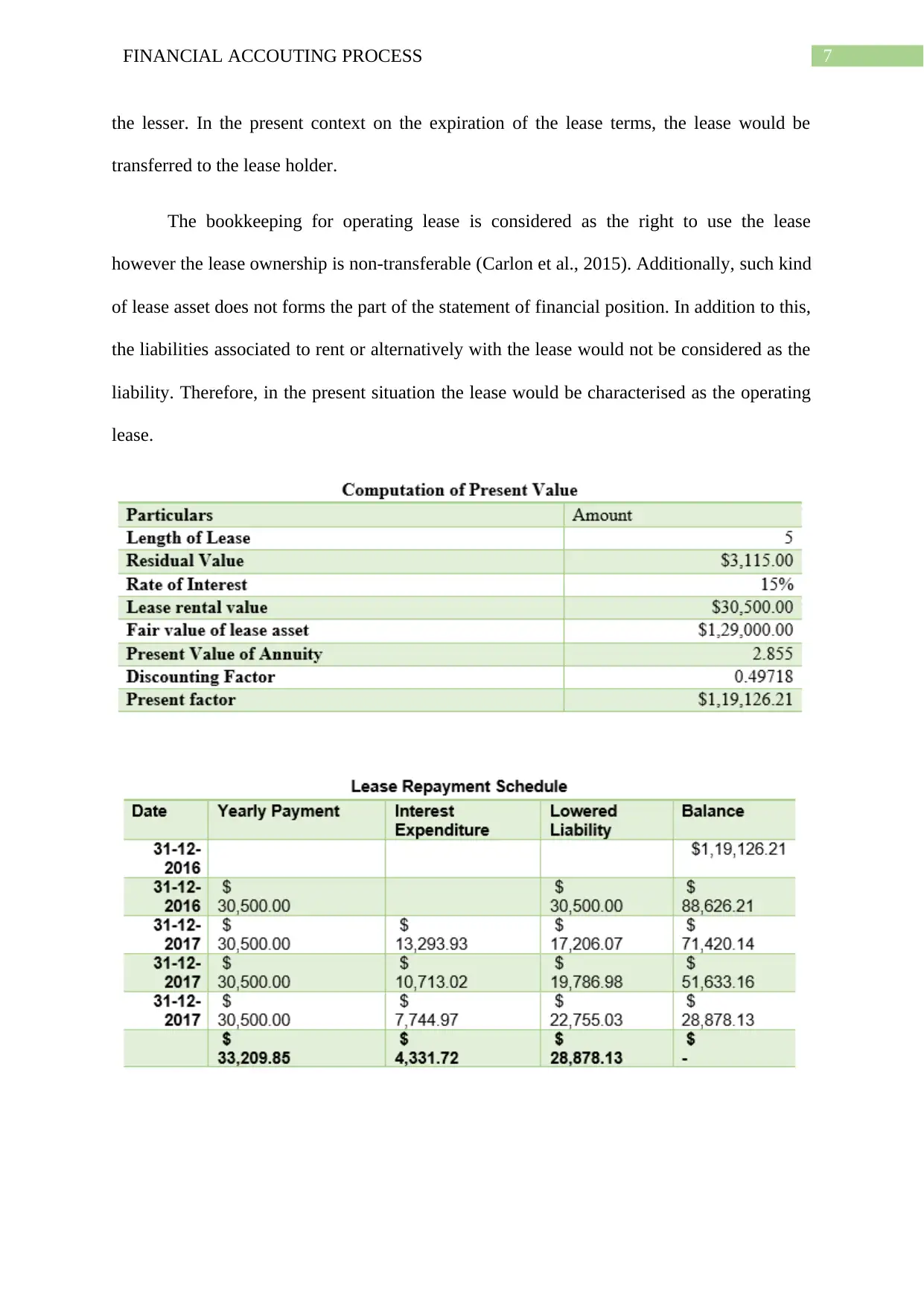
7FINANCIAL ACCOUTING PROCESS
the lesser. In the present context on the expiration of the lease terms, the lease would be
transferred to the lease holder.
The bookkeeping for operating lease is considered as the right to use the lease
however the lease ownership is non-transferable (Carlon et al., 2015). Additionally, such kind
of lease asset does not forms the part of the statement of financial position. In addition to this,
the liabilities associated to rent or alternatively with the lease would not be considered as the
liability. Therefore, in the present situation the lease would be characterised as the operating
lease.
the lesser. In the present context on the expiration of the lease terms, the lease would be
transferred to the lease holder.
The bookkeeping for operating lease is considered as the right to use the lease
however the lease ownership is non-transferable (Carlon et al., 2015). Additionally, such kind
of lease asset does not forms the part of the statement of financial position. In addition to this,
the liabilities associated to rent or alternatively with the lease would not be considered as the
liability. Therefore, in the present situation the lease would be characterised as the operating
lease.
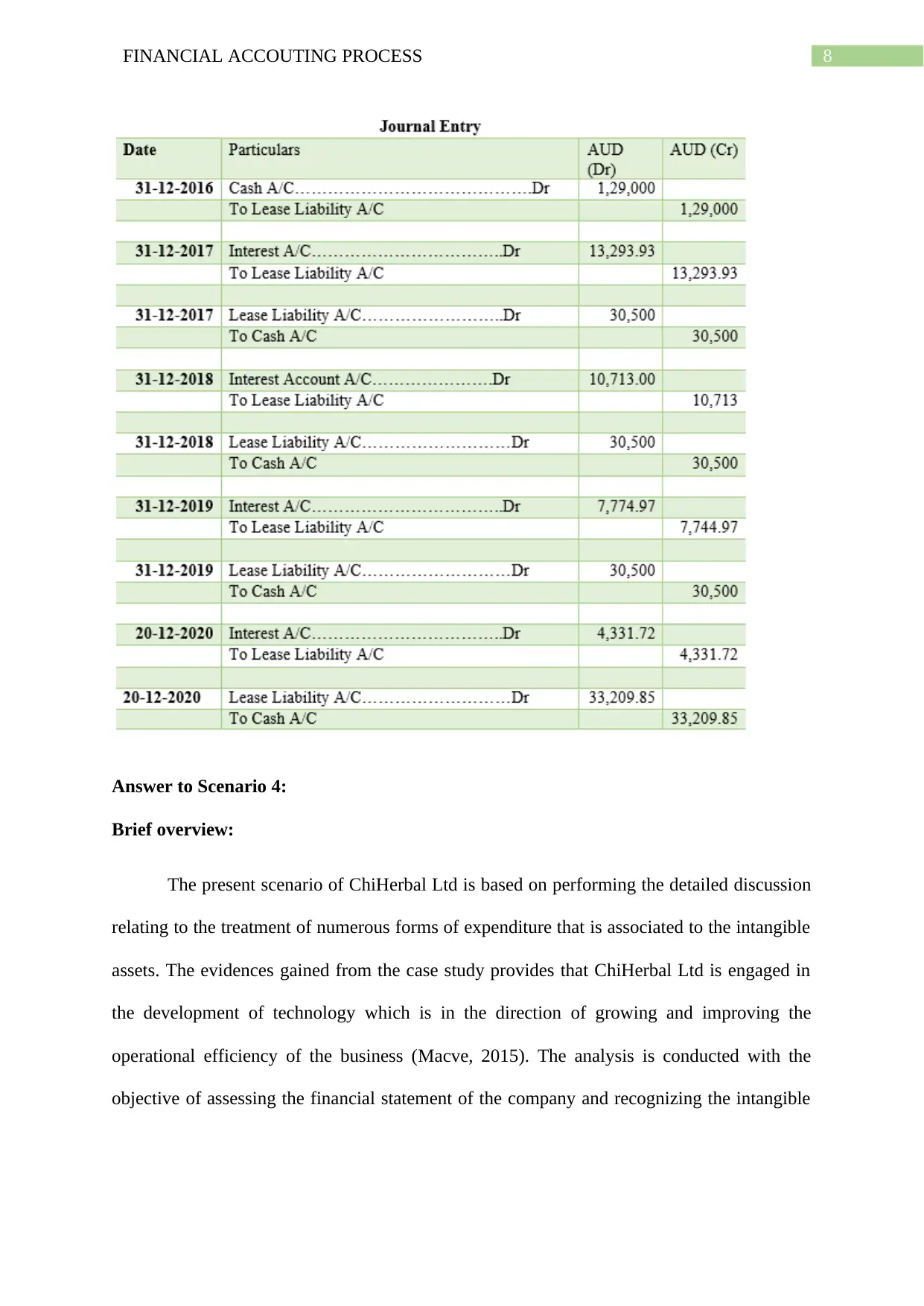
8FINANCIAL ACCOUTING PROCESS
Answer to Scenario 4:
Brief overview:
The present scenario of ChiHerbal Ltd is based on performing the detailed discussion
relating to the treatment of numerous forms of expenditure that is associated to the intangible
assets. The evidences gained from the case study provides that ChiHerbal Ltd is engaged in
the development of technology which is in the direction of growing and improving the
operational efficiency of the business (Macve, 2015). The analysis is conducted with the
objective of assessing the financial statement of the company and recognizing the intangible
Answer to Scenario 4:
Brief overview:
The present scenario of ChiHerbal Ltd is based on performing the detailed discussion
relating to the treatment of numerous forms of expenditure that is associated to the intangible
assets. The evidences gained from the case study provides that ChiHerbal Ltd is engaged in
the development of technology which is in the direction of growing and improving the
operational efficiency of the business (Macve, 2015). The analysis is conducted with the
objective of assessing the financial statement of the company and recognizing the intangible
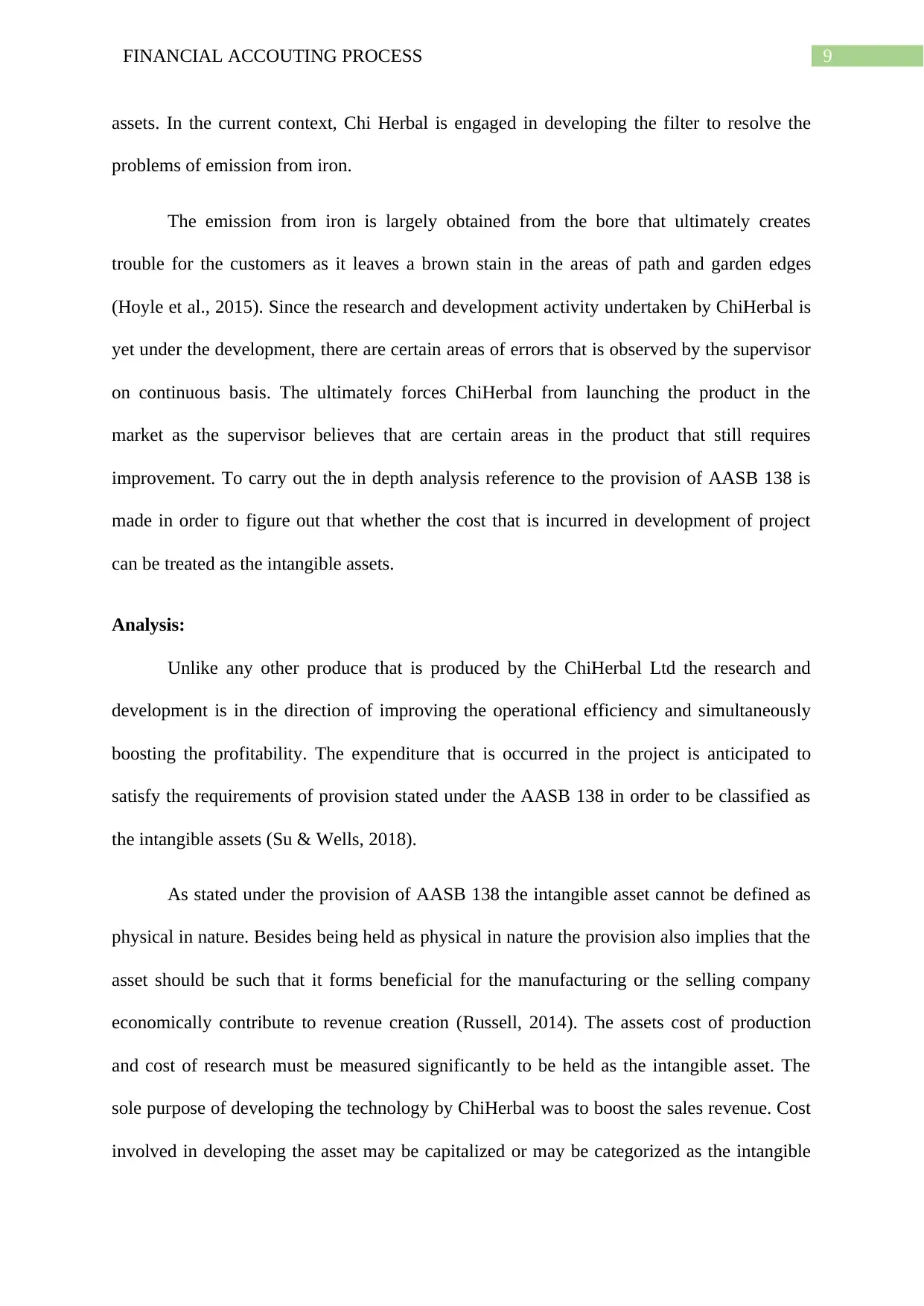
9FINANCIAL ACCOUTING PROCESS
assets. In the current context, Chi Herbal is engaged in developing the filter to resolve the
problems of emission from iron.
The emission from iron is largely obtained from the bore that ultimately creates
trouble for the customers as it leaves a brown stain in the areas of path and garden edges
(Hoyle et al., 2015). Since the research and development activity undertaken by ChiHerbal is
yet under the development, there are certain areas of errors that is observed by the supervisor
on continuous basis. The ultimately forces ChiHerbal from launching the product in the
market as the supervisor believes that are certain areas in the product that still requires
improvement. To carry out the in depth analysis reference to the provision of AASB 138 is
made in order to figure out that whether the cost that is incurred in development of project
can be treated as the intangible assets.
Analysis:
Unlike any other produce that is produced by the ChiHerbal Ltd the research and
development is in the direction of improving the operational efficiency and simultaneously
boosting the profitability. The expenditure that is occurred in the project is anticipated to
satisfy the requirements of provision stated under the AASB 138 in order to be classified as
the intangible assets (Su & Wells, 2018).
As stated under the provision of AASB 138 the intangible asset cannot be defined as
physical in nature. Besides being held as physical in nature the provision also implies that the
asset should be such that it forms beneficial for the manufacturing or the selling company
economically contribute to revenue creation (Russell, 2014). The assets cost of production
and cost of research must be measured significantly to be held as the intangible asset. The
sole purpose of developing the technology by ChiHerbal was to boost the sales revenue. Cost
involved in developing the asset may be capitalized or may be categorized as the intangible
assets. In the current context, Chi Herbal is engaged in developing the filter to resolve the
problems of emission from iron.
The emission from iron is largely obtained from the bore that ultimately creates
trouble for the customers as it leaves a brown stain in the areas of path and garden edges
(Hoyle et al., 2015). Since the research and development activity undertaken by ChiHerbal is
yet under the development, there are certain areas of errors that is observed by the supervisor
on continuous basis. The ultimately forces ChiHerbal from launching the product in the
market as the supervisor believes that are certain areas in the product that still requires
improvement. To carry out the in depth analysis reference to the provision of AASB 138 is
made in order to figure out that whether the cost that is incurred in development of project
can be treated as the intangible assets.
Analysis:
Unlike any other produce that is produced by the ChiHerbal Ltd the research and
development is in the direction of improving the operational efficiency and simultaneously
boosting the profitability. The expenditure that is occurred in the project is anticipated to
satisfy the requirements of provision stated under the AASB 138 in order to be classified as
the intangible assets (Su & Wells, 2018).
As stated under the provision of AASB 138 the intangible asset cannot be defined as
physical in nature. Besides being held as physical in nature the provision also implies that the
asset should be such that it forms beneficial for the manufacturing or the selling company
economically contribute to revenue creation (Russell, 2014). The assets cost of production
and cost of research must be measured significantly to be held as the intangible asset. The
sole purpose of developing the technology by ChiHerbal was to boost the sales revenue. Cost
involved in developing the asset may be capitalized or may be categorized as the intangible
Secure Best Marks with AI Grader
Need help grading? Try our AI Grader for instant feedback on your assignments.
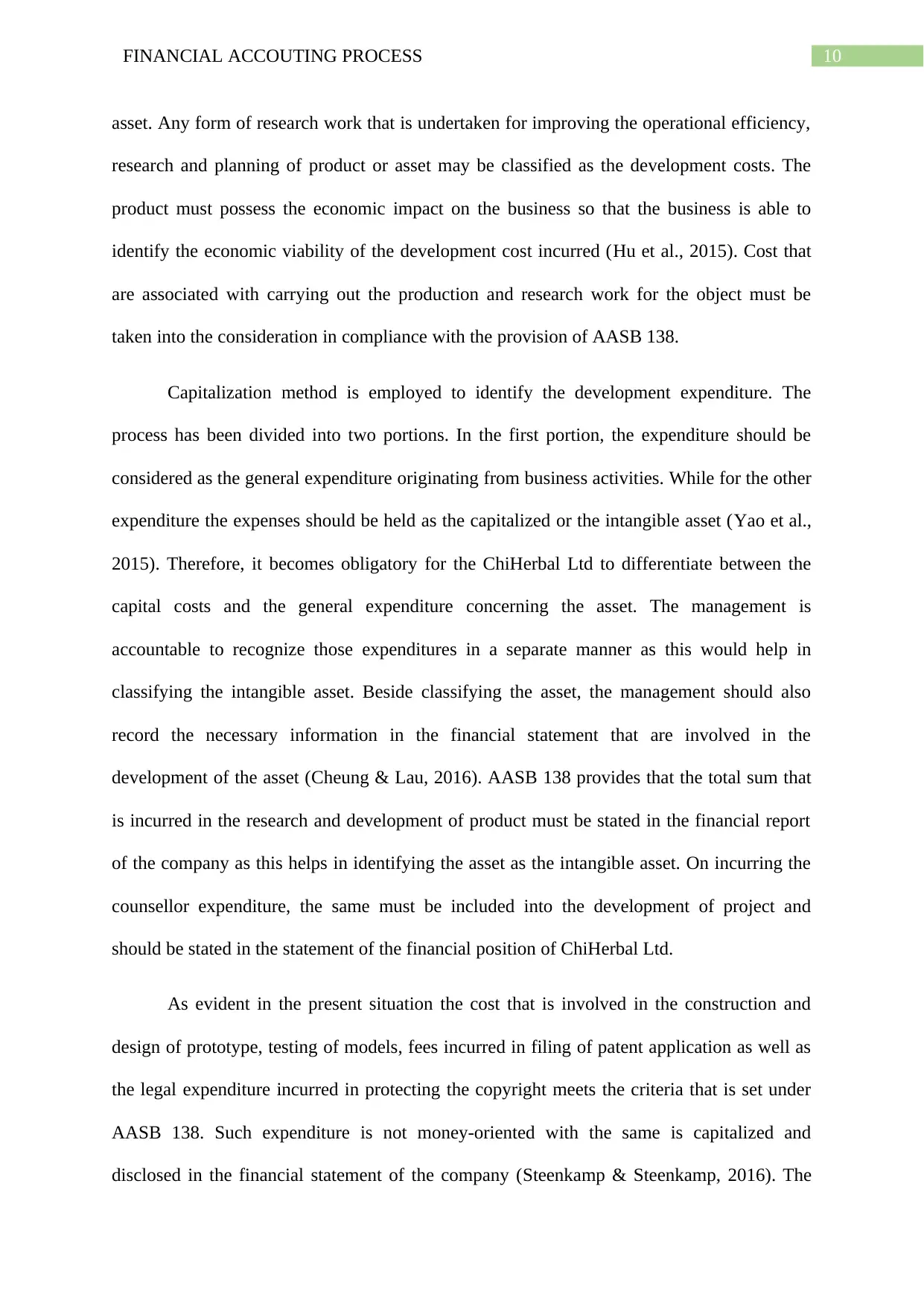
10FINANCIAL ACCOUTING PROCESS
asset. Any form of research work that is undertaken for improving the operational efficiency,
research and planning of product or asset may be classified as the development costs. The
product must possess the economic impact on the business so that the business is able to
identify the economic viability of the development cost incurred (Hu et al., 2015). Cost that
are associated with carrying out the production and research work for the object must be
taken into the consideration in compliance with the provision of AASB 138.
Capitalization method is employed to identify the development expenditure. The
process has been divided into two portions. In the first portion, the expenditure should be
considered as the general expenditure originating from business activities. While for the other
expenditure the expenses should be held as the capitalized or the intangible asset (Yao et al.,
2015). Therefore, it becomes obligatory for the ChiHerbal Ltd to differentiate between the
capital costs and the general expenditure concerning the asset. The management is
accountable to recognize those expenditures in a separate manner as this would help in
classifying the intangible asset. Beside classifying the asset, the management should also
record the necessary information in the financial statement that are involved in the
development of the asset (Cheung & Lau, 2016). AASB 138 provides that the total sum that
is incurred in the research and development of product must be stated in the financial report
of the company as this helps in identifying the asset as the intangible asset. On incurring the
counsellor expenditure, the same must be included into the development of project and
should be stated in the statement of the financial position of ChiHerbal Ltd.
As evident in the present situation the cost that is involved in the construction and
design of prototype, testing of models, fees incurred in filing of patent application as well as
the legal expenditure incurred in protecting the copyright meets the criteria that is set under
AASB 138. Such expenditure is not money-oriented with the same is capitalized and
disclosed in the financial statement of the company (Steenkamp & Steenkamp, 2016). The
asset. Any form of research work that is undertaken for improving the operational efficiency,
research and planning of product or asset may be classified as the development costs. The
product must possess the economic impact on the business so that the business is able to
identify the economic viability of the development cost incurred (Hu et al., 2015). Cost that
are associated with carrying out the production and research work for the object must be
taken into the consideration in compliance with the provision of AASB 138.
Capitalization method is employed to identify the development expenditure. The
process has been divided into two portions. In the first portion, the expenditure should be
considered as the general expenditure originating from business activities. While for the other
expenditure the expenses should be held as the capitalized or the intangible asset (Yao et al.,
2015). Therefore, it becomes obligatory for the ChiHerbal Ltd to differentiate between the
capital costs and the general expenditure concerning the asset. The management is
accountable to recognize those expenditures in a separate manner as this would help in
classifying the intangible asset. Beside classifying the asset, the management should also
record the necessary information in the financial statement that are involved in the
development of the asset (Cheung & Lau, 2016). AASB 138 provides that the total sum that
is incurred in the research and development of product must be stated in the financial report
of the company as this helps in identifying the asset as the intangible asset. On incurring the
counsellor expenditure, the same must be included into the development of project and
should be stated in the statement of the financial position of ChiHerbal Ltd.
As evident in the present situation the cost that is involved in the construction and
design of prototype, testing of models, fees incurred in filing of patent application as well as
the legal expenditure incurred in protecting the copyright meets the criteria that is set under
AASB 138. Such expenditure is not money-oriented with the same is capitalized and
disclosed in the financial statement of the company (Steenkamp & Steenkamp, 2016). The
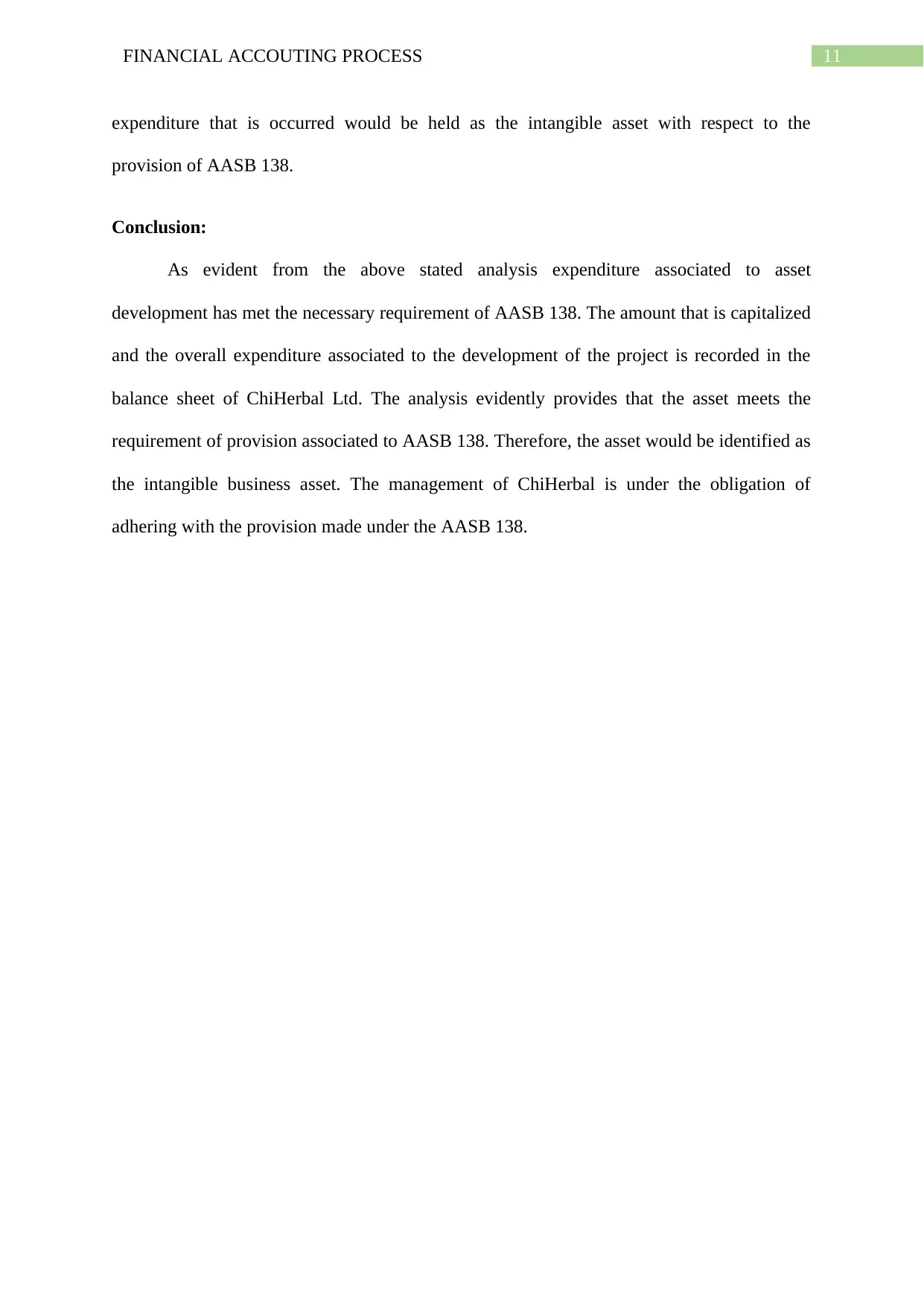
11FINANCIAL ACCOUTING PROCESS
expenditure that is occurred would be held as the intangible asset with respect to the
provision of AASB 138.
Conclusion:
As evident from the above stated analysis expenditure associated to asset
development has met the necessary requirement of AASB 138. The amount that is capitalized
and the overall expenditure associated to the development of the project is recorded in the
balance sheet of ChiHerbal Ltd. The analysis evidently provides that the asset meets the
requirement of provision associated to AASB 138. Therefore, the asset would be identified as
the intangible business asset. The management of ChiHerbal is under the obligation of
adhering with the provision made under the AASB 138.
expenditure that is occurred would be held as the intangible asset with respect to the
provision of AASB 138.
Conclusion:
As evident from the above stated analysis expenditure associated to asset
development has met the necessary requirement of AASB 138. The amount that is capitalized
and the overall expenditure associated to the development of the project is recorded in the
balance sheet of ChiHerbal Ltd. The analysis evidently provides that the asset meets the
requirement of provision associated to AASB 138. Therefore, the asset would be identified as
the intangible business asset. The management of ChiHerbal is under the obligation of
adhering with the provision made under the AASB 138.
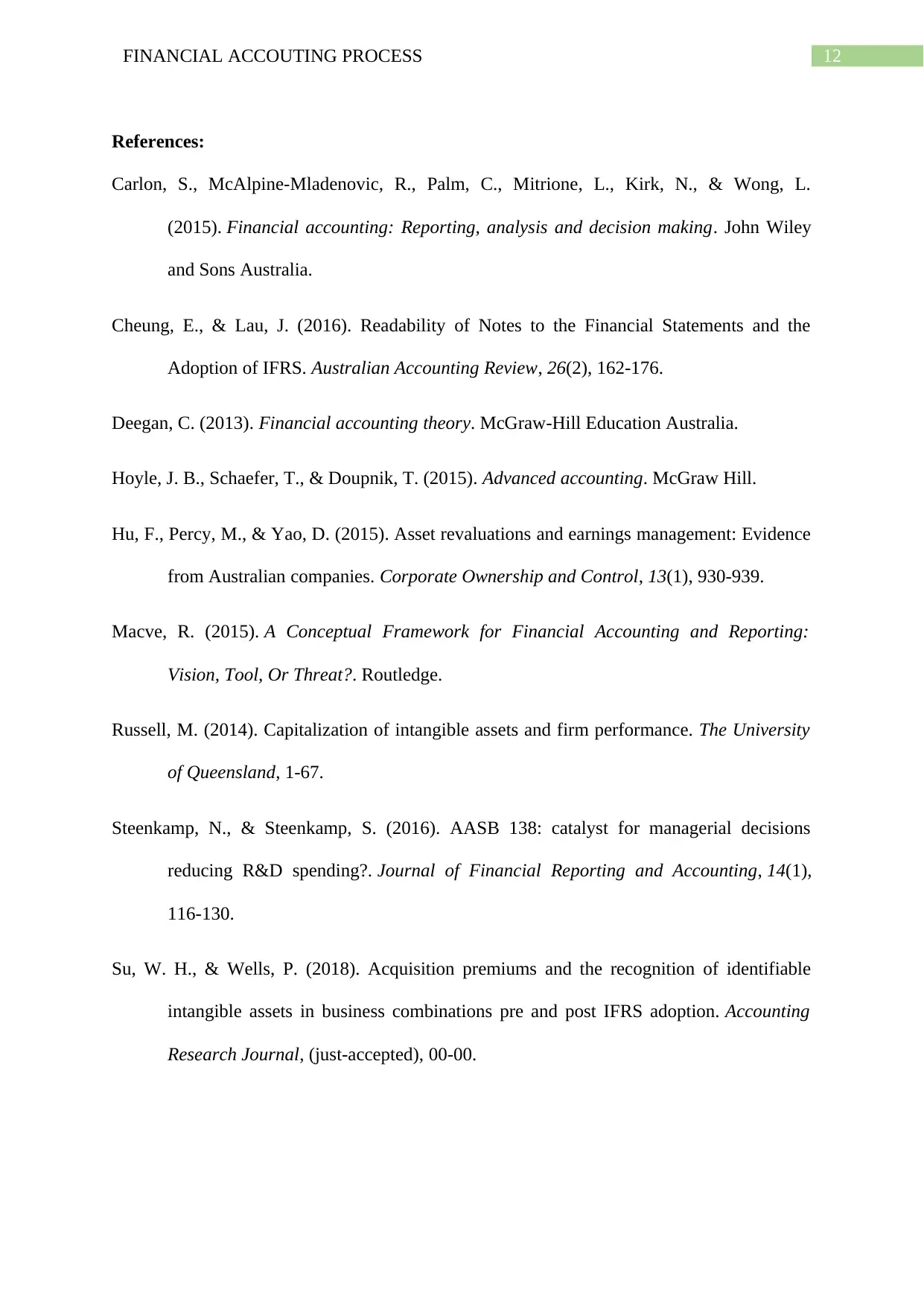
12FINANCIAL ACCOUTING PROCESS
References:
Carlon, S., McAlpine-Mladenovic, R., Palm, C., Mitrione, L., Kirk, N., & Wong, L.
(2015). Financial accounting: Reporting, analysis and decision making. John Wiley
and Sons Australia.
Cheung, E., & Lau, J. (2016). Readability of Notes to the Financial Statements and the
Adoption of IFRS. Australian Accounting Review, 26(2), 162-176.
Deegan, C. (2013). Financial accounting theory. McGraw-Hill Education Australia.
Hoyle, J. B., Schaefer, T., & Doupnik, T. (2015). Advanced accounting. McGraw Hill.
Hu, F., Percy, M., & Yao, D. (2015). Asset revaluations and earnings management: Evidence
from Australian companies. Corporate Ownership and Control, 13(1), 930-939.
Macve, R. (2015). A Conceptual Framework for Financial Accounting and Reporting:
Vision, Tool, Or Threat?. Routledge.
Russell, M. (2014). Capitalization of intangible assets and firm performance. The University
of Queensland, 1-67.
Steenkamp, N., & Steenkamp, S. (2016). AASB 138: catalyst for managerial decisions
reducing R&D spending?. Journal of Financial Reporting and Accounting, 14(1),
116-130.
Su, W. H., & Wells, P. (2018). Acquisition premiums and the recognition of identifiable
intangible assets in business combinations pre and post IFRS adoption. Accounting
Research Journal, (just-accepted), 00-00.
References:
Carlon, S., McAlpine-Mladenovic, R., Palm, C., Mitrione, L., Kirk, N., & Wong, L.
(2015). Financial accounting: Reporting, analysis and decision making. John Wiley
and Sons Australia.
Cheung, E., & Lau, J. (2016). Readability of Notes to the Financial Statements and the
Adoption of IFRS. Australian Accounting Review, 26(2), 162-176.
Deegan, C. (2013). Financial accounting theory. McGraw-Hill Education Australia.
Hoyle, J. B., Schaefer, T., & Doupnik, T. (2015). Advanced accounting. McGraw Hill.
Hu, F., Percy, M., & Yao, D. (2015). Asset revaluations and earnings management: Evidence
from Australian companies. Corporate Ownership and Control, 13(1), 930-939.
Macve, R. (2015). A Conceptual Framework for Financial Accounting and Reporting:
Vision, Tool, Or Threat?. Routledge.
Russell, M. (2014). Capitalization of intangible assets and firm performance. The University
of Queensland, 1-67.
Steenkamp, N., & Steenkamp, S. (2016). AASB 138: catalyst for managerial decisions
reducing R&D spending?. Journal of Financial Reporting and Accounting, 14(1),
116-130.
Su, W. H., & Wells, P. (2018). Acquisition premiums and the recognition of identifiable
intangible assets in business combinations pre and post IFRS adoption. Accounting
Research Journal, (just-accepted), 00-00.
Paraphrase This Document
Need a fresh take? Get an instant paraphrase of this document with our AI Paraphraser
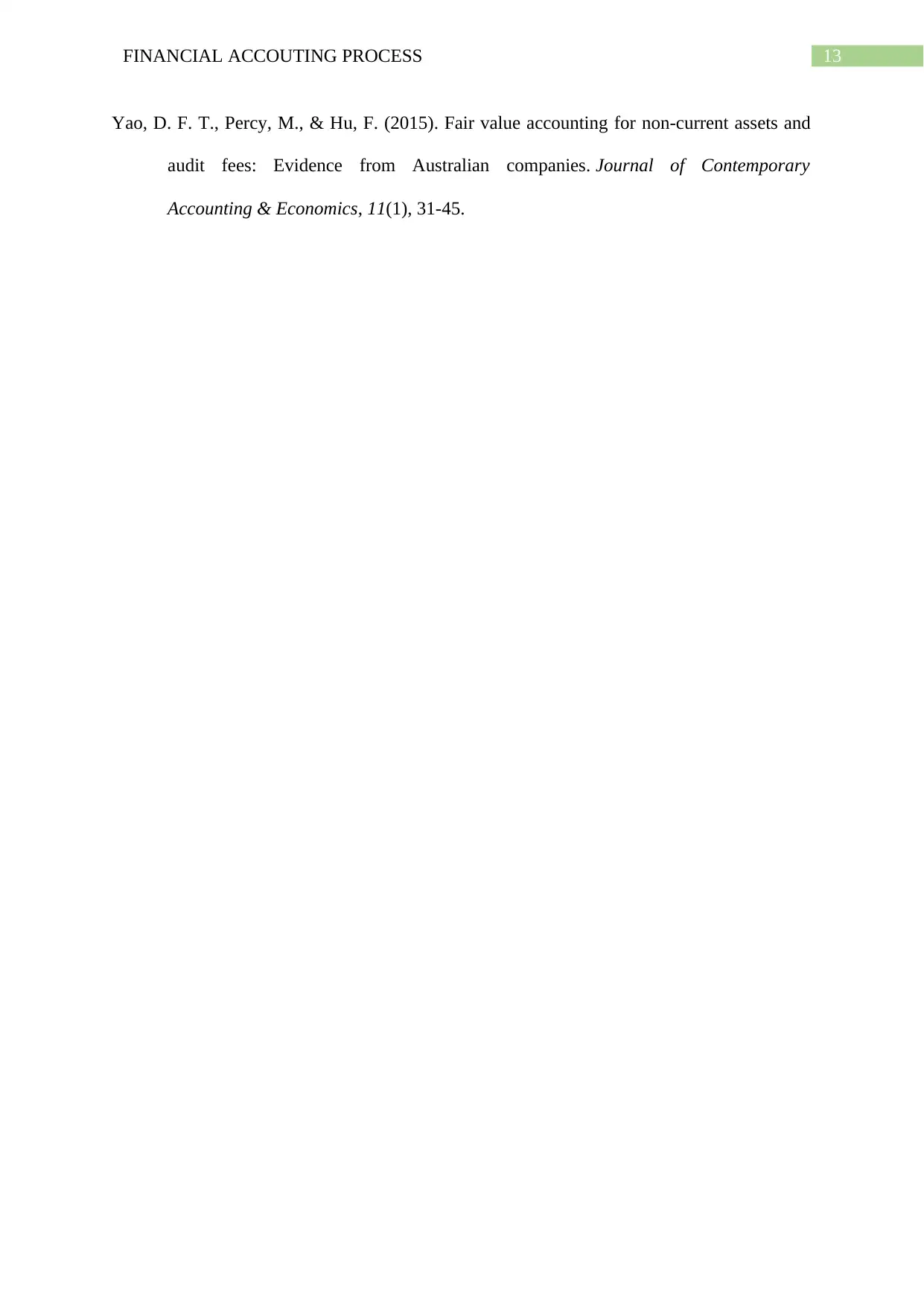
13FINANCIAL ACCOUTING PROCESS
Yao, D. F. T., Percy, M., & Hu, F. (2015). Fair value accounting for non-current assets and
audit fees: Evidence from Australian companies. Journal of Contemporary
Accounting & Economics, 11(1), 31-45.
Yao, D. F. T., Percy, M., & Hu, F. (2015). Fair value accounting for non-current assets and
audit fees: Evidence from Australian companies. Journal of Contemporary
Accounting & Economics, 11(1), 31-45.
1 out of 14
Your All-in-One AI-Powered Toolkit for Academic Success.
+13062052269
info@desklib.com
Available 24*7 on WhatsApp / Email
![[object Object]](/_next/static/media/star-bottom.7253800d.svg)
Unlock your academic potential
© 2024 | Zucol Services PVT LTD | All rights reserved.


